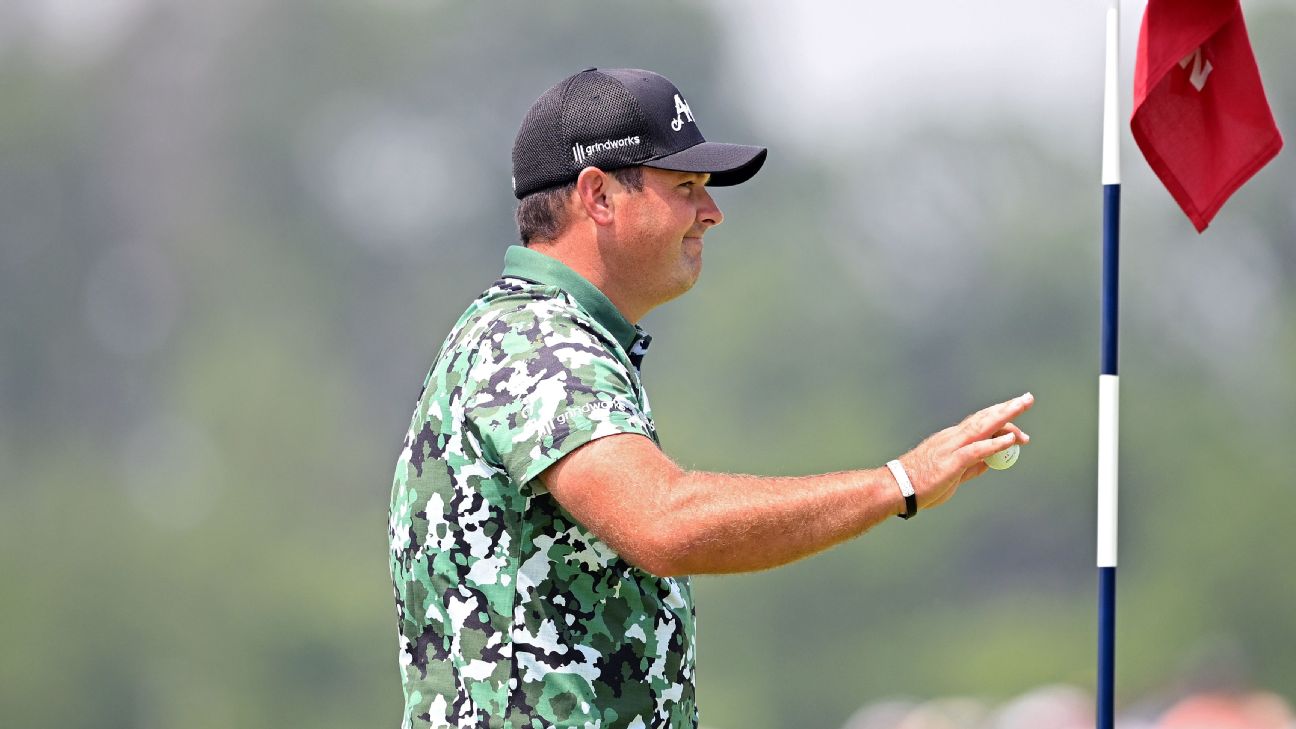The opening round of the U.S. Open at Oakmont, a notoriously challenging course, delivered a truly extraordinary moment on Thursday. Patrick Reed, the 2018 Masters champion, etched his name into golf history by executing an incredibly rare shot: an albatross, also known as a double eagle. This feat, only the fourth ever recorded in the U.S.
Open since records began approximately four decades ago, generated immense excitement. However, the sheer brilliance of this shot was ultimately overshadowed by a difficult finish to his round. Despite the historic achievement, Reed concluded his opening day with a 3-over 73, a score that reflected the brutal nature of Oakmont and some subsequent struggles.
The Historic Double Eagle at Oakmont
The highlight of Reed’s round, and indeed one of the most memorable moments of the tournament, occurred early in his play.
A Near-Impossible Feat on Hole 4
The magical moment unfolded on the par-5 fourth hole at Oakmont. Reed, facing a formidable distance, struck his second shot from an astounding 286 yards. With precision and power, he chose a 3-wood for this audacious attempt. The ball soared through the air, landed softly on the green, bounced a remarkable three times, and then, to the collective astonishment of everyone watching, rolled directly into the hole. This incredible shot resulted in a double eagle, scoring three strokes under par on a single hole.
The immediate impact of this albatross was significant for Reed’s scorecard. After having bogeyed the second hole, putting him at 1-over, this spectacular shot instantly propelled him to 2-under par. It was a dramatic swing that momentarily put him in a strong position on the leaderboard, a testament to the immense value of such a rare golf shot.
The sheer difficulty of achieving an albatross, especially at a major championship venue like Oakmont, underscored the extraordinary nature of Reed’s accomplishment.
Reed’s Reaction and the Rarity of the Shot
Upon striking the ball, Reed himself seemed momentarily unsure of its fate. After watching his fairway wood shot land on the green and roll, he initially appeared stunned. He then raised his palm to the sky, a gesture of uncertainty, before quickly pointing downward, signaling his query: “Did it go in?” The resounding applause and cheers from the spectators up at the green provided him with the definitive answer. “Oh, it’s awesome. That’s great,” Reed later remarked, acknowledging the shot’s brilliance.
The “albatross,” or double eagle, is universally regarded as the rarest shot in golf. Its rarity far surpasses even that of a hole-in-one. While approximately 30,000 holes-in-one are recorded globally each year, only a few hundred albatrosses are made worldwide annually. For context, making an albatross is statistically considered to be 10 times harder than making a hole-in-one.
Reed himself confirmed that this was the third albatross of his career, a remarkable achievement for any professional golfer. His previous two double eagles speak to his skill and perhaps a touch of good fortune when hitting long approach shots.
The Back Nine Battle: Giving Shots Back
Despite the historic start, the remainder of Reed’s round at Oakmont proved to be a challenging grind.
A Difficult Stretch After the Albatross
The exhilaration of the double eagle was unfortunately short-lived in terms of its positive impact on Reed’s overall score. Over the subsequent 14 holes, from the 5th to the 18th, Reed “gave all of that back and then some.” This phrase eloquently describes the difficulty he encountered on Oakmont’s famously demanding layout.
The course, known for its severe greens, treacherous bunkers, and unforgiving rough, began to extract its toll. Reed struggled to maintain the momentum he had gained on the fourth hole, accumulating bogeys and even a triple bogey in the latter part of his round.
This swing from 2-under par to 3-over par highlights the brutal reality of major championship golf. Even the most incredible individual shot can be undone by the cumulative challenges of a tough course. Reed’s ability to compartmentalize and focus on the remaining holes, despite the emotional rollercoaster, is a testament to the mental fortitude required at this level of the sport. His struggles after the albatross serve as a stark reminder that one great shot does not guarantee a great round, especially at the U.S. Open.
The Triple Bogey Finish
Reed’s round concluded on a particularly frustrating note. He suffered a triple bogey on the 18th hole, a notoriously difficult finishing hole at Oakmont. This significant setback pushed his score further up the leaderboard, resulting in an opening-round 3-over 73. The triple bogey underscored the challenging conditions and the mental and physical demands placed on players throughout their rounds. This final struggle made the memory of the albatross somewhat bittersweet, as Reed himself alluded to in his post-round comments.
When asked about the double eagle, Reed’s response was characteristically blunt and focused on the bigger picture of the tournament: “There’s 71 other holes we have to play. One hole doesn’t mean jack, to be honest with you.” This quote perfectly encapsulates the mindset of a professional golfer in a major championship.
While the albatross was a spectacular and historic moment, Reed quickly shifted his focus to the remaining three rounds, understanding that consistency, not just isolated brilliance, is what determines success at the U.S. Open. He acknowledged the shot’s awesomeness but admitted, “after you finish with a triple, that’s really the last thing you’re really thinking about.” This candid remark highlighted the immediate disappointment of his finish overriding the elation of his historic shot.
Reed’s Place in U.S. Open History
Patrick Reed’s albatross places him in an exclusive club of golfers who have achieved this rarest of feats at the U.S. Open.
An Exclusive Club of Double Eagle Makers
Patrick Reed now stands alongside a very select group of players who have carded an albatross at the U.S. Open since the event began keeping official records in 1983. He joins a legendary list of names that includes:
- T.C. Chen (1985 at Oakland Hills): Chen’s albatross was a memorable moment in the U.S. Open’s history, showcasing the incredible skill required to achieve such a shot.
- Shaun Micheel (2010 at Pebble Beach): Micheel’s double eagle came during a memorable U.S. Open held at the iconic Pebble Beach Golf Links, adding to the drama of the tournament.
- Nick Watney (2012 at Olympic): Watney’s albatross at Olympic Club further solidified the rarity of the shot in major championship play.
Reed’s inclusion in this elite quartet underscores the truly exceptional nature of his double eagle at Oakmont. It is a moment that will forever be part of U.S. Open lore, cementing his place in the tournament’s history books for a remarkable individual achievement, regardless of his final score for the round. This rare feat will be replayed and remembered for years to come, solidifying his unique contribution to the U.S. Open’s extensive catalog of memorable moments. His name will now be inextricably linked with these past legends who also achieved the seemingly impossible.
The Challenge of Oakmont
Oakmont Country Club is renowned for its difficulty, providing a stern test even for the world’s best golfers.
A Course That Forgives No Mistakes
Oakmont Country Club, located in Plum, Pennsylvania, is widely considered one of the most challenging golf courses in the world, particularly when hosting the U.S. Open. Its reputation for extreme difficulty is well-earned, stemming from several key features.
The course is characterized by its unforgiving rough, which can swallow golf balls and make recovery shots incredibly challenging. Its lightning-fast, undulating greens are legendary for their severe slopes and subtle breaks, demanding immense precision and touch from players. Even a slight misjudgment on the putting surface can lead to a quick three-putt or worse.
Furthermore, Oakmont features numerous strategically placed bunkers, both around the greens and in the fairways, designed to punish errant shots. The course’s length, combined with its tight fairways, places a premium on accuracy off the tee. These elements collectively create a relentless test for golfers, where even the slightest mistake can be heavily penalized.
Patrick Reed’s experience, swinging from a historic high to a triple bogey, is a perfect illustration of Oakmont’s ability to humble even the most accomplished players. The course demands unwavering focus, strategic course management, and exceptional execution on every single shot, highlighting why the U.S. Open at Oakmont is often considered the ultimate test in golf.








